Ethical Analysis of Leadership in Business: Gibbs Cycle
VerifiedAdded on 2023/01/18
|7
|1655
|77
Report
AI Summary
This report analyzes ethical leadership in business, focusing on the ethical dilemmas faced by leaders. It examines the concept of leadership, differentiating between managerial and leadership functions, and highlights the importance of ethics in business. The report uses the Gibbs reflection cycle to a...
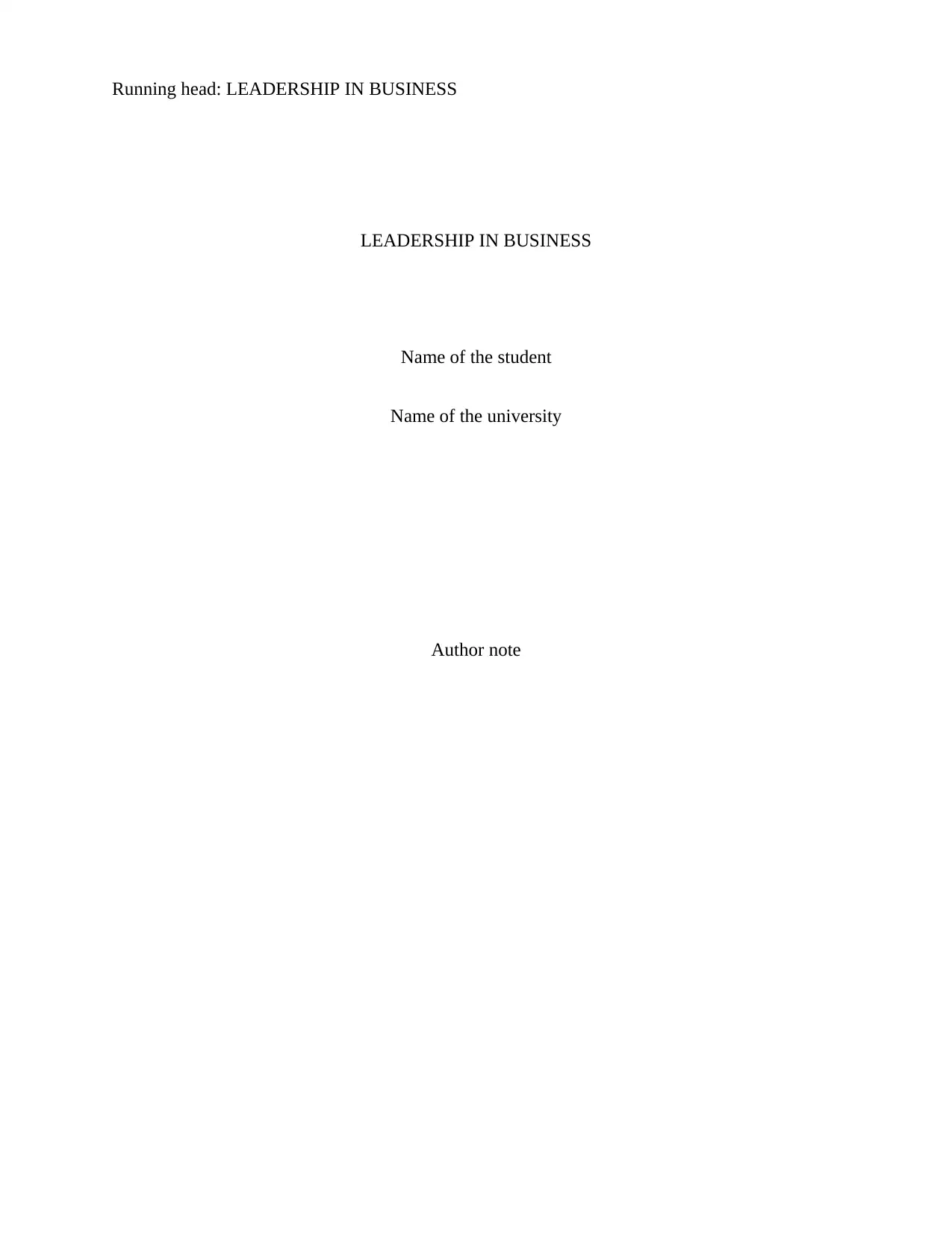
Running head: LEADERSHIP IN BUSINESS
LEADERSHIP IN BUSINESS
Name of the student
Name of the university
Author note
LEADERSHIP IN BUSINESS
Name of the student
Name of the university
Author note
Paraphrase This Document
Need a fresh take? Get an instant paraphrase of this document with our AI Paraphraser
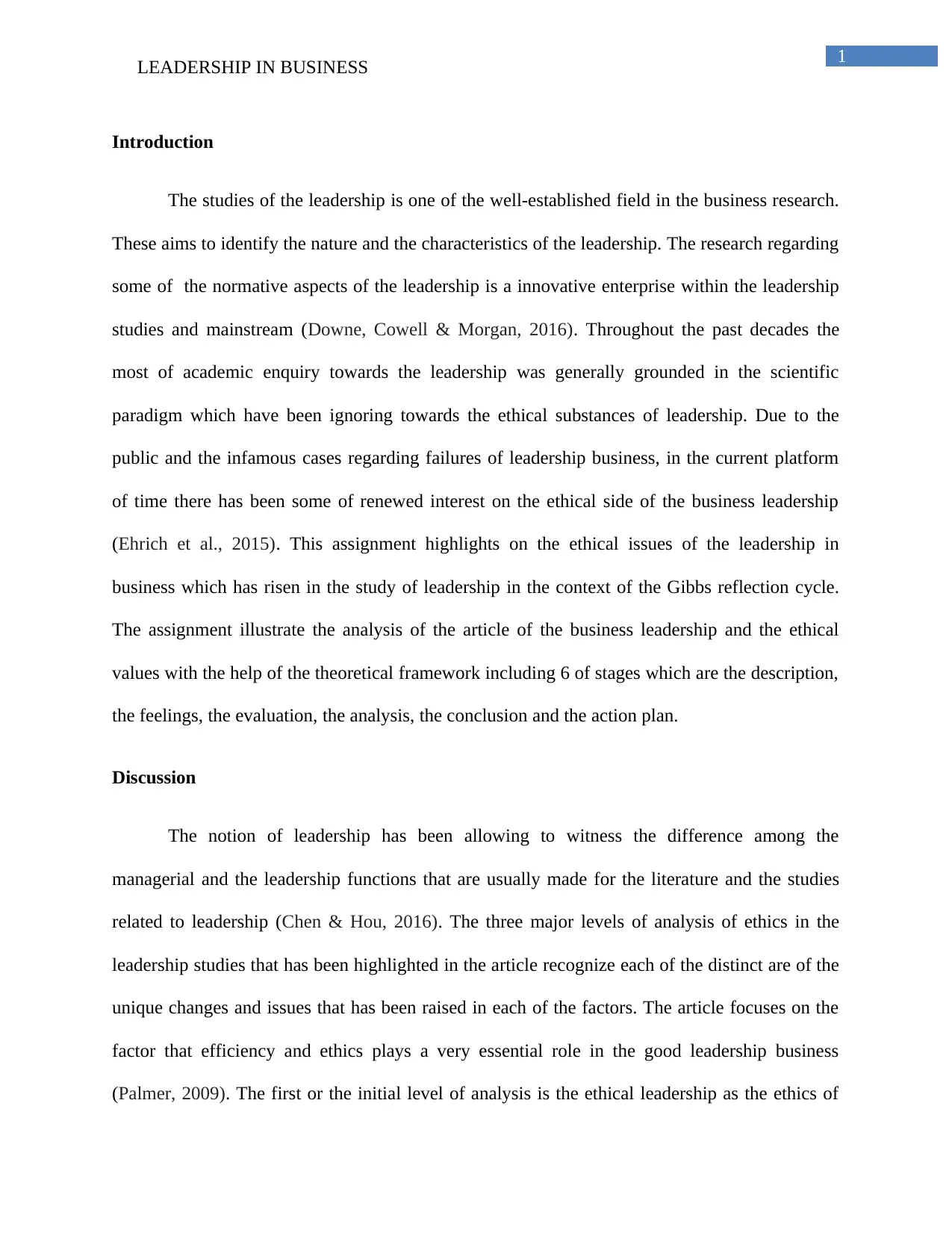
1
LEADERSHIP IN BUSINESS
Introduction
The studies of the leadership is one of the well-established field in the business research.
These aims to identify the nature and the characteristics of the leadership. The research regarding
some of the normative aspects of the leadership is a innovative enterprise within the leadership
studies and mainstream (Downe, Cowell & Morgan, 2016). Throughout the past decades the
most of academic enquiry towards the leadership was generally grounded in the scientific
paradigm which have been ignoring towards the ethical substances of leadership. Due to the
public and the infamous cases regarding failures of leadership business, in the current platform
of time there has been some of renewed interest on the ethical side of the business leadership
(Ehrich et al., 2015). This assignment highlights on the ethical issues of the leadership in
business which has risen in the study of leadership in the context of the Gibbs reflection cycle.
The assignment illustrate the analysis of the article of the business leadership and the ethical
values with the help of the theoretical framework including 6 of stages which are the description,
the feelings, the evaluation, the analysis, the conclusion and the action plan.
Discussion
The notion of leadership has been allowing to witness the difference among the
managerial and the leadership functions that are usually made for the literature and the studies
related to leadership (Chen & Hou, 2016). The three major levels of analysis of ethics in the
leadership studies that has been highlighted in the article recognize each of the distinct are of the
unique changes and issues that has been raised in each of the factors. The article focuses on the
factor that efficiency and ethics plays a very essential role in the good leadership business
(Palmer, 2009). The first or the initial level of analysis is the ethical leadership as the ethics of
LEADERSHIP IN BUSINESS
Introduction
The studies of the leadership is one of the well-established field in the business research.
These aims to identify the nature and the characteristics of the leadership. The research regarding
some of the normative aspects of the leadership is a innovative enterprise within the leadership
studies and mainstream (Downe, Cowell & Morgan, 2016). Throughout the past decades the
most of academic enquiry towards the leadership was generally grounded in the scientific
paradigm which have been ignoring towards the ethical substances of leadership. Due to the
public and the infamous cases regarding failures of leadership business, in the current platform
of time there has been some of renewed interest on the ethical side of the business leadership
(Ehrich et al., 2015). This assignment highlights on the ethical issues of the leadership in
business which has risen in the study of leadership in the context of the Gibbs reflection cycle.
The assignment illustrate the analysis of the article of the business leadership and the ethical
values with the help of the theoretical framework including 6 of stages which are the description,
the feelings, the evaluation, the analysis, the conclusion and the action plan.
Discussion
The notion of leadership has been allowing to witness the difference among the
managerial and the leadership functions that are usually made for the literature and the studies
related to leadership (Chen & Hou, 2016). The three major levels of analysis of ethics in the
leadership studies that has been highlighted in the article recognize each of the distinct are of the
unique changes and issues that has been raised in each of the factors. The article focuses on the
factor that efficiency and ethics plays a very essential role in the good leadership business
(Palmer, 2009). The first or the initial level of analysis is the ethical leadership as the ethics of
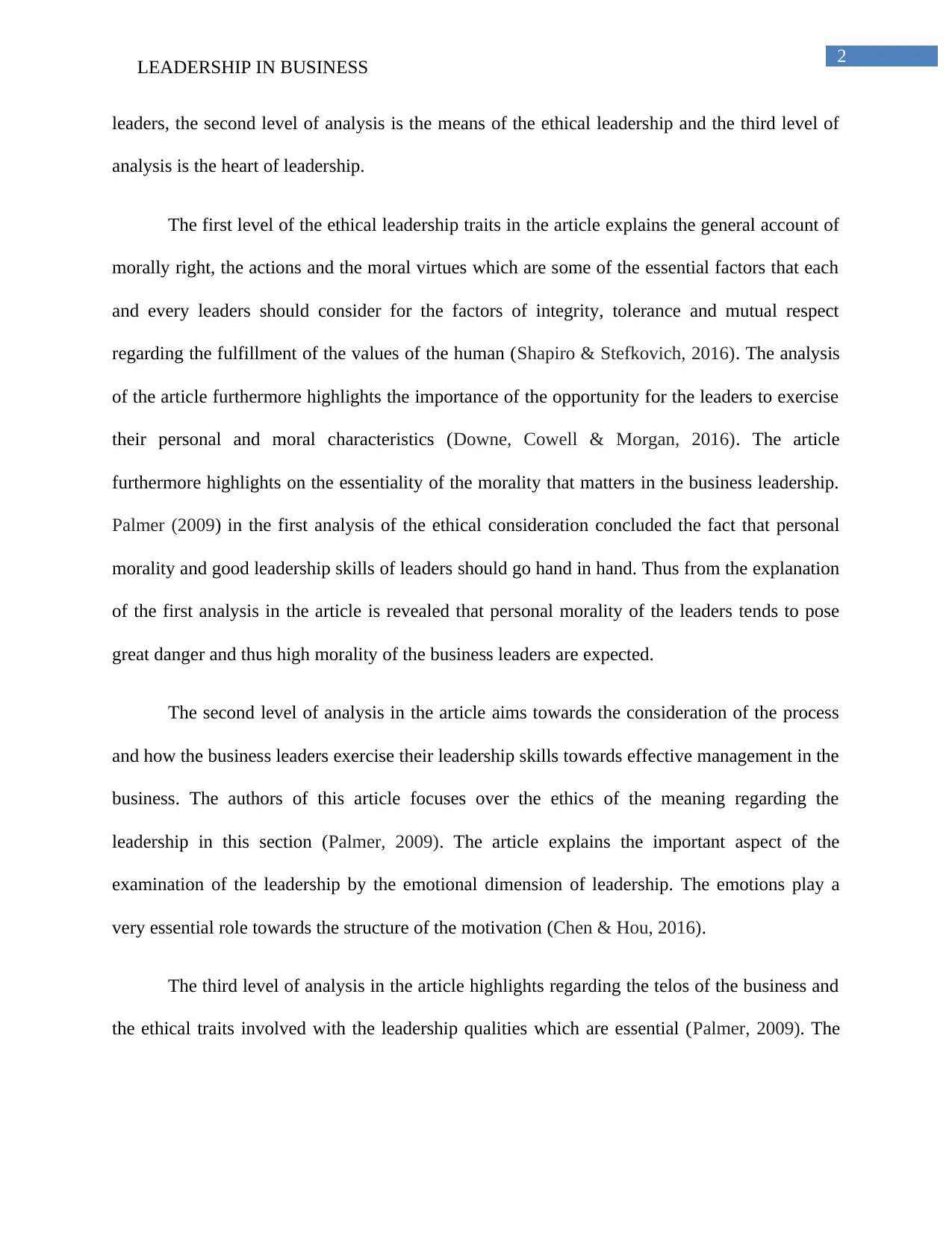
2
LEADERSHIP IN BUSINESS
leaders, the second level of analysis is the means of the ethical leadership and the third level of
analysis is the heart of leadership.
The first level of the ethical leadership traits in the article explains the general account of
morally right, the actions and the moral virtues which are some of the essential factors that each
and every leaders should consider for the factors of integrity, tolerance and mutual respect
regarding the fulfillment of the values of the human (Shapiro & Stefkovich, 2016). The analysis
of the article furthermore highlights the importance of the opportunity for the leaders to exercise
their personal and moral characteristics (Downe, Cowell & Morgan, 2016). The article
furthermore highlights on the essentiality of the morality that matters in the business leadership.
Palmer (2009) in the first analysis of the ethical consideration concluded the fact that personal
morality and good leadership skills of leaders should go hand in hand. Thus from the explanation
of the first analysis in the article is revealed that personal morality of the leaders tends to pose
great danger and thus high morality of the business leaders are expected.
The second level of analysis in the article aims towards the consideration of the process
and how the business leaders exercise their leadership skills towards effective management in the
business. The authors of this article focuses over the ethics of the meaning regarding the
leadership in this section (Palmer, 2009). The article explains the important aspect of the
examination of the leadership by the emotional dimension of leadership. The emotions play a
very essential role towards the structure of the motivation (Chen & Hou, 2016).
The third level of analysis in the article highlights regarding the telos of the business and
the ethical traits involved with the leadership qualities which are essential (Palmer, 2009). The
LEADERSHIP IN BUSINESS
leaders, the second level of analysis is the means of the ethical leadership and the third level of
analysis is the heart of leadership.
The first level of the ethical leadership traits in the article explains the general account of
morally right, the actions and the moral virtues which are some of the essential factors that each
and every leaders should consider for the factors of integrity, tolerance and mutual respect
regarding the fulfillment of the values of the human (Shapiro & Stefkovich, 2016). The analysis
of the article furthermore highlights the importance of the opportunity for the leaders to exercise
their personal and moral characteristics (Downe, Cowell & Morgan, 2016). The article
furthermore highlights on the essentiality of the morality that matters in the business leadership.
Palmer (2009) in the first analysis of the ethical consideration concluded the fact that personal
morality and good leadership skills of leaders should go hand in hand. Thus from the explanation
of the first analysis in the article is revealed that personal morality of the leaders tends to pose
great danger and thus high morality of the business leaders are expected.
The second level of analysis in the article aims towards the consideration of the process
and how the business leaders exercise their leadership skills towards effective management in the
business. The authors of this article focuses over the ethics of the meaning regarding the
leadership in this section (Palmer, 2009). The article explains the important aspect of the
examination of the leadership by the emotional dimension of leadership. The emotions play a
very essential role towards the structure of the motivation (Chen & Hou, 2016).
The third level of analysis in the article highlights regarding the telos of the business and
the ethical traits involved with the leadership qualities which are essential (Palmer, 2009). The
⊘ This is a preview!⊘
Do you want full access?
Subscribe today to unlock all pages.

Trusted by 1+ million students worldwide
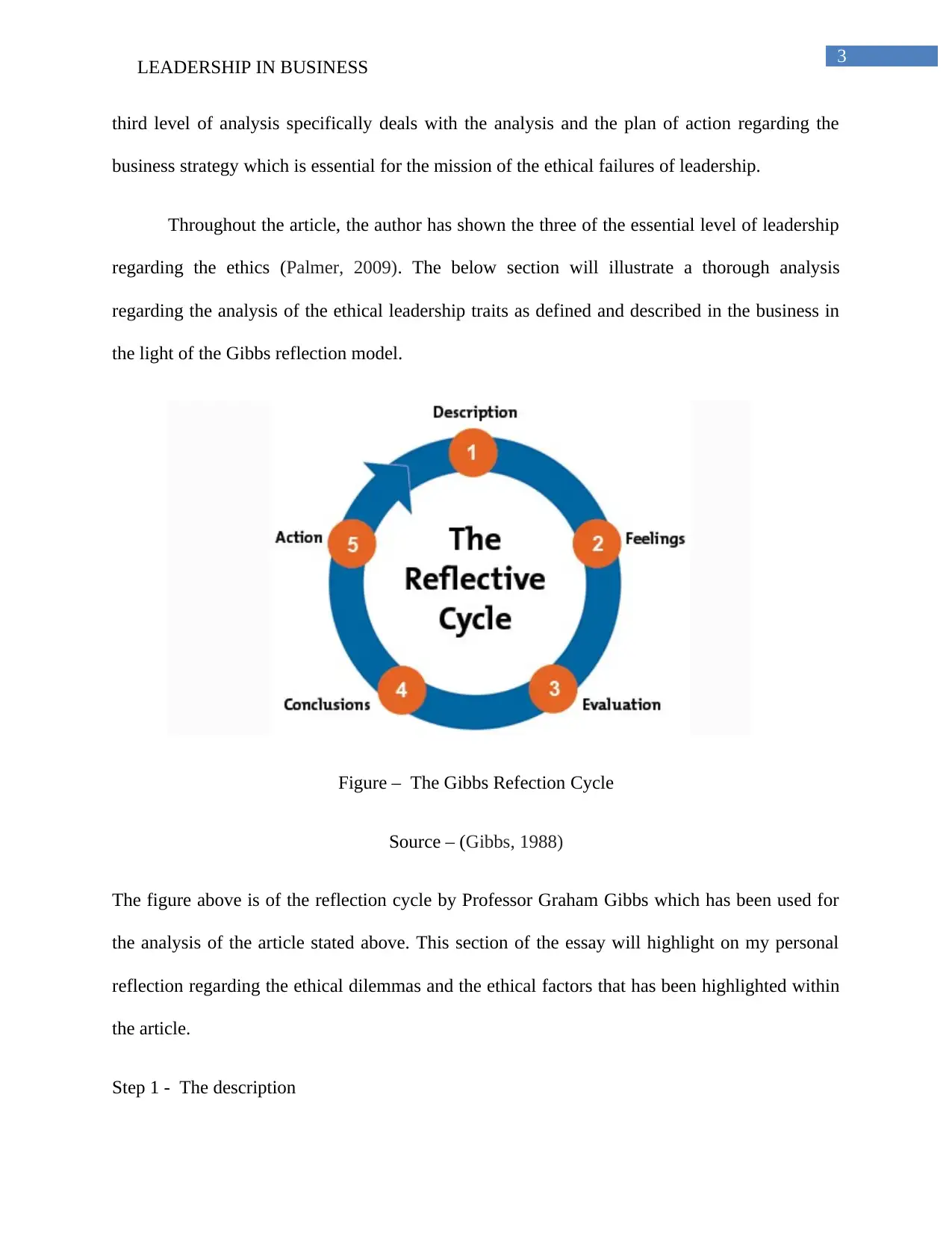
3
LEADERSHIP IN BUSINESS
third level of analysis specifically deals with the analysis and the plan of action regarding the
business strategy which is essential for the mission of the ethical failures of leadership.
Throughout the article, the author has shown the three of the essential level of leadership
regarding the ethics (Palmer, 2009). The below section will illustrate a thorough analysis
regarding the analysis of the ethical leadership traits as defined and described in the business in
the light of the Gibbs reflection model.
Figure – The Gibbs Refection Cycle
Source – (Gibbs, 1988)
The figure above is of the reflection cycle by Professor Graham Gibbs which has been used for
the analysis of the article stated above. This section of the essay will highlight on my personal
reflection regarding the ethical dilemmas and the ethical factors that has been highlighted within
the article.
Step 1 - The description
LEADERSHIP IN BUSINESS
third level of analysis specifically deals with the analysis and the plan of action regarding the
business strategy which is essential for the mission of the ethical failures of leadership.
Throughout the article, the author has shown the three of the essential level of leadership
regarding the ethics (Palmer, 2009). The below section will illustrate a thorough analysis
regarding the analysis of the ethical leadership traits as defined and described in the business in
the light of the Gibbs reflection model.
Figure – The Gibbs Refection Cycle
Source – (Gibbs, 1988)
The figure above is of the reflection cycle by Professor Graham Gibbs which has been used for
the analysis of the article stated above. This section of the essay will highlight on my personal
reflection regarding the ethical dilemmas and the ethical factors that has been highlighted within
the article.
Step 1 - The description
Paraphrase This Document
Need a fresh take? Get an instant paraphrase of this document with our AI Paraphraser
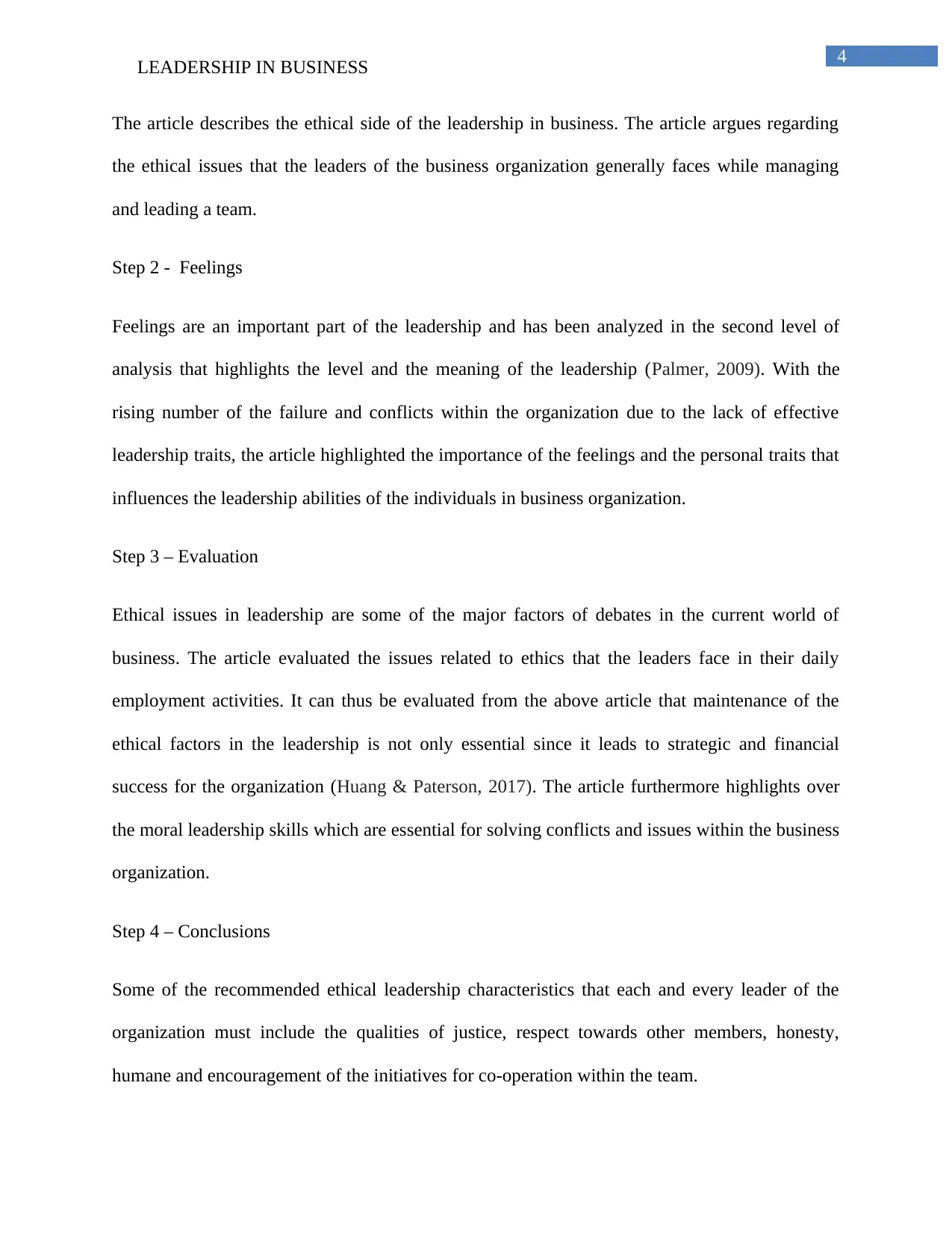
4
LEADERSHIP IN BUSINESS
The article describes the ethical side of the leadership in business. The article argues regarding
the ethical issues that the leaders of the business organization generally faces while managing
and leading a team.
Step 2 - Feelings
Feelings are an important part of the leadership and has been analyzed in the second level of
analysis that highlights the level and the meaning of the leadership (Palmer, 2009). With the
rising number of the failure and conflicts within the organization due to the lack of effective
leadership traits, the article highlighted the importance of the feelings and the personal traits that
influences the leadership abilities of the individuals in business organization.
Step 3 – Evaluation
Ethical issues in leadership are some of the major factors of debates in the current world of
business. The article evaluated the issues related to ethics that the leaders face in their daily
employment activities. It can thus be evaluated from the above article that maintenance of the
ethical factors in the leadership is not only essential since it leads to strategic and financial
success for the organization (Huang & Paterson, 2017). The article furthermore highlights over
the moral leadership skills which are essential for solving conflicts and issues within the business
organization.
Step 4 – Conclusions
Some of the recommended ethical leadership characteristics that each and every leader of the
organization must include the qualities of justice, respect towards other members, honesty,
humane and encouragement of the initiatives for co-operation within the team.
LEADERSHIP IN BUSINESS
The article describes the ethical side of the leadership in business. The article argues regarding
the ethical issues that the leaders of the business organization generally faces while managing
and leading a team.
Step 2 - Feelings
Feelings are an important part of the leadership and has been analyzed in the second level of
analysis that highlights the level and the meaning of the leadership (Palmer, 2009). With the
rising number of the failure and conflicts within the organization due to the lack of effective
leadership traits, the article highlighted the importance of the feelings and the personal traits that
influences the leadership abilities of the individuals in business organization.
Step 3 – Evaluation
Ethical issues in leadership are some of the major factors of debates in the current world of
business. The article evaluated the issues related to ethics that the leaders face in their daily
employment activities. It can thus be evaluated from the above article that maintenance of the
ethical factors in the leadership is not only essential since it leads to strategic and financial
success for the organization (Huang & Paterson, 2017). The article furthermore highlights over
the moral leadership skills which are essential for solving conflicts and issues within the business
organization.
Step 4 – Conclusions
Some of the recommended ethical leadership characteristics that each and every leader of the
organization must include the qualities of justice, respect towards other members, honesty,
humane and encouragement of the initiatives for co-operation within the team.
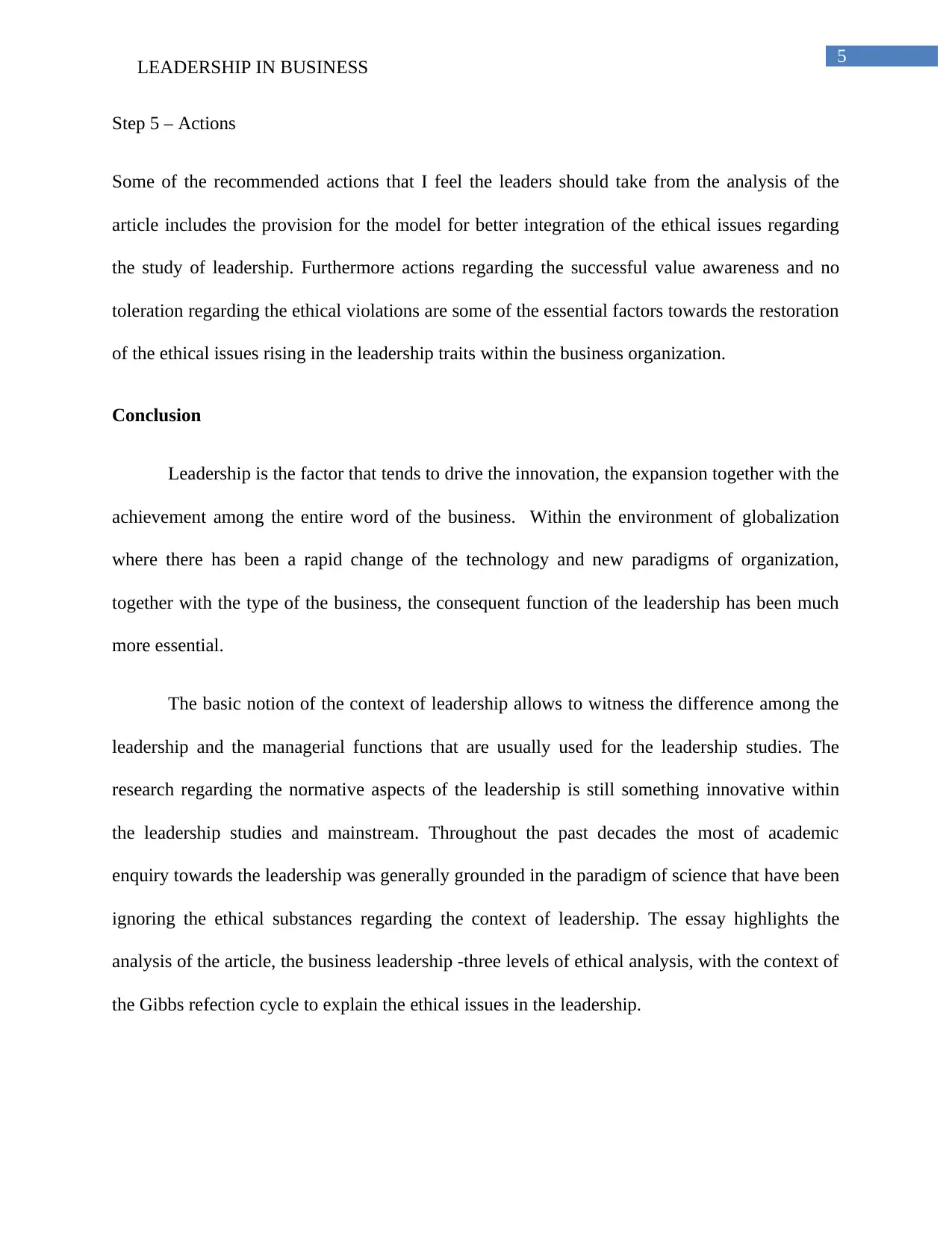
5
LEADERSHIP IN BUSINESS
Step 5 – Actions
Some of the recommended actions that I feel the leaders should take from the analysis of the
article includes the provision for the model for better integration of the ethical issues regarding
the study of leadership. Furthermore actions regarding the successful value awareness and no
toleration regarding the ethical violations are some of the essential factors towards the restoration
of the ethical issues rising in the leadership traits within the business organization.
Conclusion
Leadership is the factor that tends to drive the innovation, the expansion together with the
achievement among the entire word of the business. Within the environment of globalization
where there has been a rapid change of the technology and new paradigms of organization,
together with the type of the business, the consequent function of the leadership has been much
more essential.
The basic notion of the context of leadership allows to witness the difference among the
leadership and the managerial functions that are usually used for the leadership studies. The
research regarding the normative aspects of the leadership is still something innovative within
the leadership studies and mainstream. Throughout the past decades the most of academic
enquiry towards the leadership was generally grounded in the paradigm of science that have been
ignoring the ethical substances regarding the context of leadership. The essay highlights the
analysis of the article, the business leadership -three levels of ethical analysis, with the context of
the Gibbs refection cycle to explain the ethical issues in the leadership.
LEADERSHIP IN BUSINESS
Step 5 – Actions
Some of the recommended actions that I feel the leaders should take from the analysis of the
article includes the provision for the model for better integration of the ethical issues regarding
the study of leadership. Furthermore actions regarding the successful value awareness and no
toleration regarding the ethical violations are some of the essential factors towards the restoration
of the ethical issues rising in the leadership traits within the business organization.
Conclusion
Leadership is the factor that tends to drive the innovation, the expansion together with the
achievement among the entire word of the business. Within the environment of globalization
where there has been a rapid change of the technology and new paradigms of organization,
together with the type of the business, the consequent function of the leadership has been much
more essential.
The basic notion of the context of leadership allows to witness the difference among the
leadership and the managerial functions that are usually used for the leadership studies. The
research regarding the normative aspects of the leadership is still something innovative within
the leadership studies and mainstream. Throughout the past decades the most of academic
enquiry towards the leadership was generally grounded in the paradigm of science that have been
ignoring the ethical substances regarding the context of leadership. The essay highlights the
analysis of the article, the business leadership -three levels of ethical analysis, with the context of
the Gibbs refection cycle to explain the ethical issues in the leadership.
⊘ This is a preview!⊘
Do you want full access?
Subscribe today to unlock all pages.

Trusted by 1+ million students worldwide
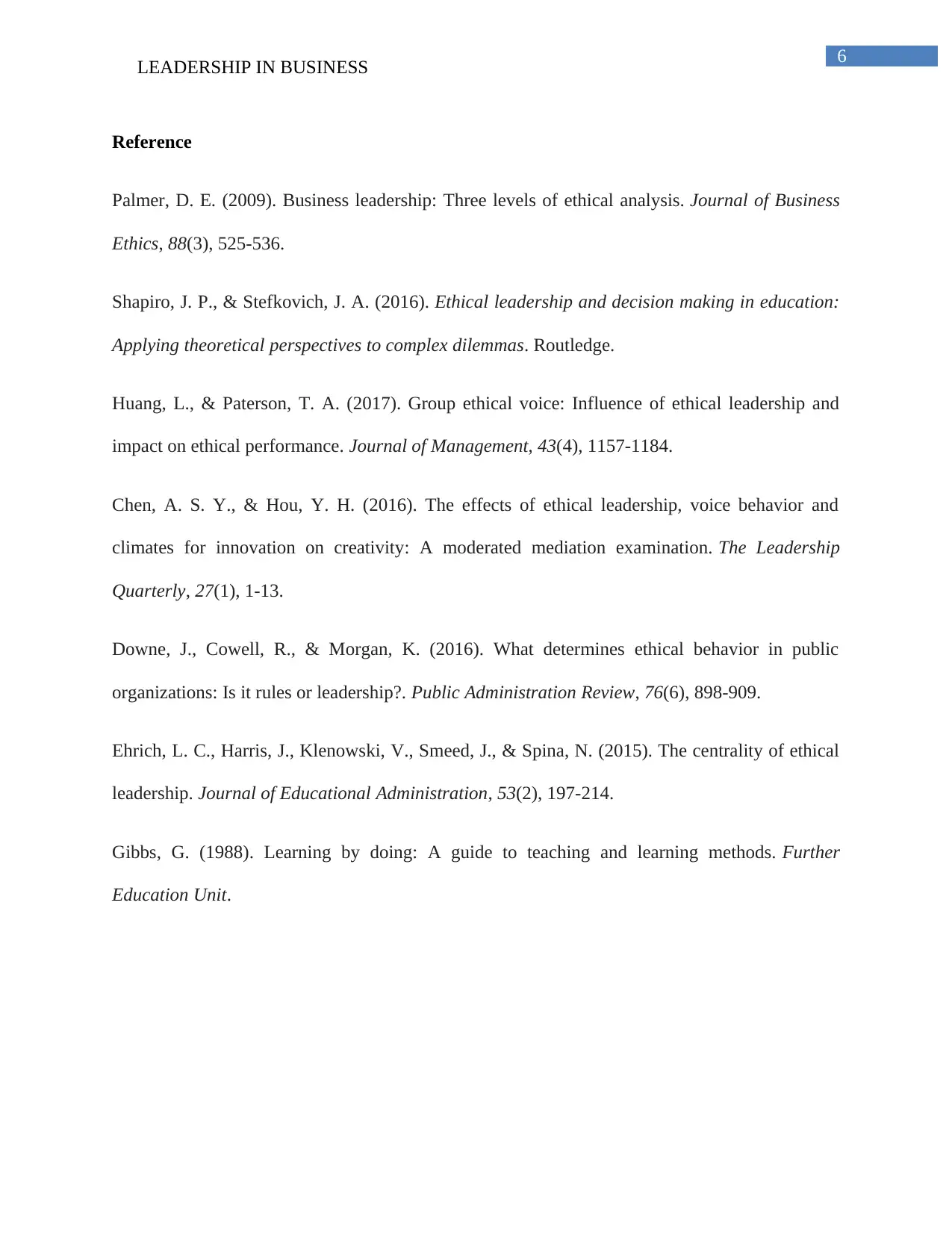
6
LEADERSHIP IN BUSINESS
Reference
Palmer, D. E. (2009). Business leadership: Three levels of ethical analysis. Journal of Business
Ethics, 88(3), 525-536.
Shapiro, J. P., & Stefkovich, J. A. (2016). Ethical leadership and decision making in education:
Applying theoretical perspectives to complex dilemmas. Routledge.
Huang, L., & Paterson, T. A. (2017). Group ethical voice: Influence of ethical leadership and
impact on ethical performance. Journal of Management, 43(4), 1157-1184.
Chen, A. S. Y., & Hou, Y. H. (2016). The effects of ethical leadership, voice behavior and
climates for innovation on creativity: A moderated mediation examination. The Leadership
Quarterly, 27(1), 1-13.
Downe, J., Cowell, R., & Morgan, K. (2016). What determines ethical behavior in public
organizations: Is it rules or leadership?. Public Administration Review, 76(6), 898-909.
Ehrich, L. C., Harris, J., Klenowski, V., Smeed, J., & Spina, N. (2015). The centrality of ethical
leadership. Journal of Educational Administration, 53(2), 197-214.
Gibbs, G. (1988). Learning by doing: A guide to teaching and learning methods. Further
Education Unit.
LEADERSHIP IN BUSINESS
Reference
Palmer, D. E. (2009). Business leadership: Three levels of ethical analysis. Journal of Business
Ethics, 88(3), 525-536.
Shapiro, J. P., & Stefkovich, J. A. (2016). Ethical leadership and decision making in education:
Applying theoretical perspectives to complex dilemmas. Routledge.
Huang, L., & Paterson, T. A. (2017). Group ethical voice: Influence of ethical leadership and
impact on ethical performance. Journal of Management, 43(4), 1157-1184.
Chen, A. S. Y., & Hou, Y. H. (2016). The effects of ethical leadership, voice behavior and
climates for innovation on creativity: A moderated mediation examination. The Leadership
Quarterly, 27(1), 1-13.
Downe, J., Cowell, R., & Morgan, K. (2016). What determines ethical behavior in public
organizations: Is it rules or leadership?. Public Administration Review, 76(6), 898-909.
Ehrich, L. C., Harris, J., Klenowski, V., Smeed, J., & Spina, N. (2015). The centrality of ethical
leadership. Journal of Educational Administration, 53(2), 197-214.
Gibbs, G. (1988). Learning by doing: A guide to teaching and learning methods. Further
Education Unit.
1 out of 7
Related Documents
Your All-in-One AI-Powered Toolkit for Academic Success.
+13062052269
info@desklib.com
Available 24*7 on WhatsApp / Email
![[object Object]](/_next/static/media/star-bottom.7253800d.svg)
Unlock your academic potential
© 2024 | Zucol Services PVT LTD | All rights reserved.





